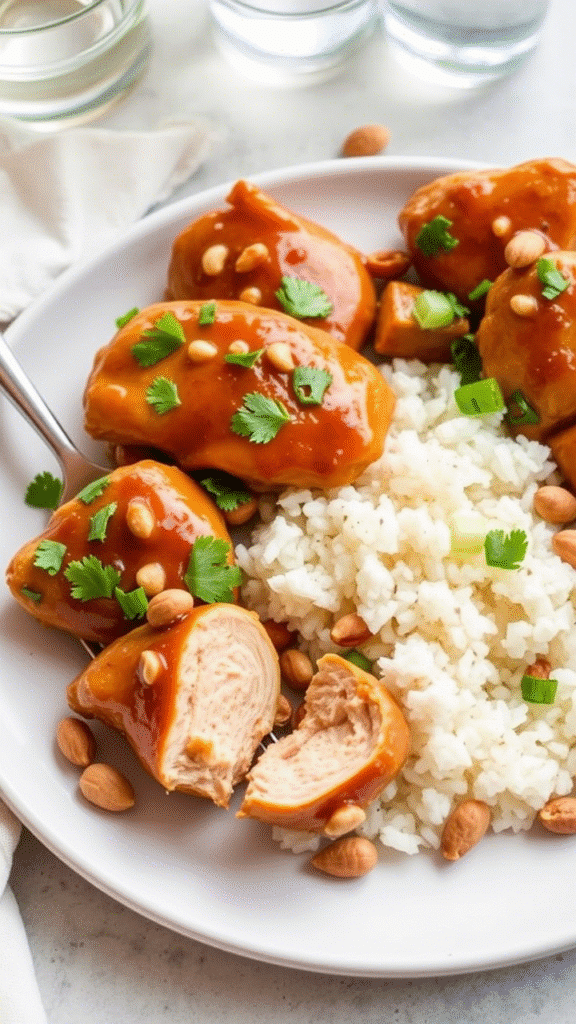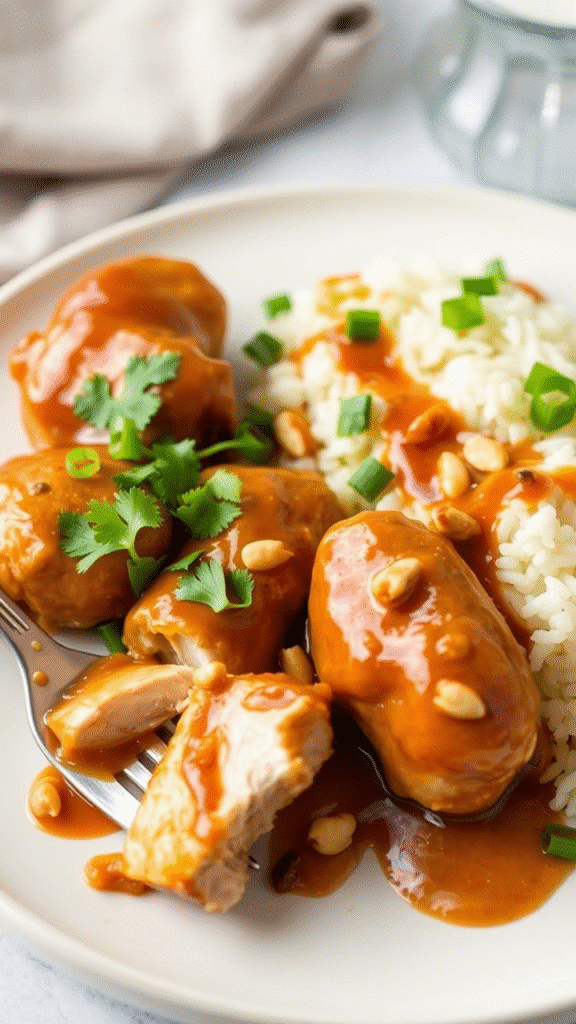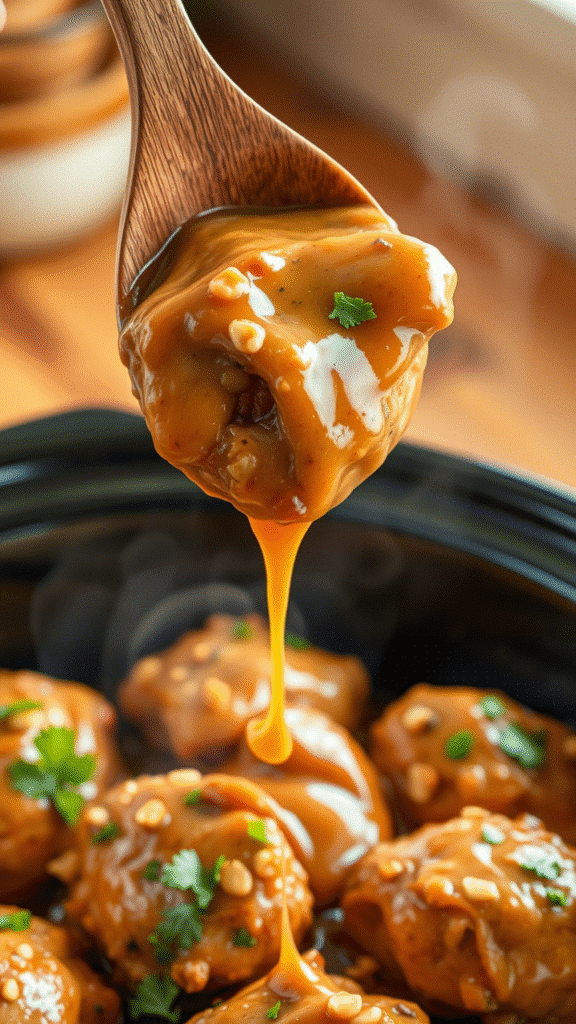Last winter, I was rummaging through my pantry during a particularly brutal snowstorm when I stumbled upon a jar of natural peanut butter that had been sitting there for months. What happened next completely transformed how I think about slow cooker cooking—and honestly, it might just change your weeknight dinner routine forever.
The marriage of tender chicken and rich, nutty peanut sauce in a slow cooker creates something truly magical. This isn’t your typical “dump and go” crockpot meal; it’s a sophisticated dish that delivers restaurant-quality flavors with minimal effort. The secret lies in understanding how peanut butter behaves under low, sustained heat, and how certain spices bloom when they have hours to meld together.
What Makes This Peanut Chicken Special
This slow cooker peanut chicken recipe draws inspiration from West African groundnut stews and Thai peanut curry traditions, creating a fusion that’s both familiar and exotic. The beauty of this dish isn’t just in its incredible flavor—it’s in how the slow cooking process transforms simple ingredients into something extraordinary.
Unlike stovetop versions that can separate or become grainy, slow cooking allows the peanut butter to emulsify naturally with the other liquids. The result is a silky, cohesive sauce that clings beautifully to every piece of chicken. You’ll notice how the sauce develops complex layers of flavor as it cooks, with the peanuts becoming more pronounced while balancing perfectly with aromatic spices.
The technique also ensures incredibly tender chicken that literally falls apart at the touch of a fork. This happens because the low, moist heat breaks down the connective tissues gradually, creating that coveted melt-in-your-mouth texture that’s impossible to achieve with faster cooking methods.
Ingredients & Substitutions
The Protein Foundation
- 2.5 pounds boneless, skinless chicken thighs (preferred) or chicken breasts
- 1 large onion, diced
- 4 cloves garlic, minced
- 1 tablespoon fresh ginger, grated
Chicken thighs are absolutely crucial here—they contain more fat and connective tissue than breasts, which means they stay incredibly moist during the long cooking process. If you must use chicken breasts, reduce the cooking time by about 30 minutes and check for doneness more frequently to prevent overcooking.
For the onion, yellow or sweet varieties work best because they caramelize beautifully over the extended cooking time. Red onions can become slightly bitter, while white onions tend to disappear completely. Fresh ginger is non-negotiable; ground ginger simply doesn’t provide the same bright, aromatic punch that develops during slow cooking.
The Peanut Base
- 3/4 cup natural peanut butter (smooth or chunky)
- 1 can (14 oz) coconut milk, full-fat
- 2 tablespoons soy sauce (low sodium preferred)
- 2 tablespoons rice vinegar
- 1 tablespoon brown sugar or honey
The type of peanut butter you choose dramatically affects the final dish. Natural peanut butter, made with just peanuts and salt, creates the cleanest flavor profile. Conventional peanut butters with added sugars and stabilizers can make the sauce overly sweet and create an artificial taste that competes with the other ingredients.
Full-fat coconut milk is essential—light versions don’t provide enough richness to balance the peanut butter’s intensity. If you’re avoiding coconut, you can substitute with heavy cream, but add it during the last hour of cooking to prevent curdling.
The Spice Symphony
- 2 teaspoons curry powder
- 1 teaspoon ground cumin
- 1/2 teaspoon smoked paprika
- 1/4 teaspoon cayenne pepper (adjust to taste)
- 1 teaspoon salt
- 1/2 teaspoon black pepper
Curry powder varies wildly between brands, so taste yours first. Some are more turmeric-forward, while others emphasize coriander or fenugreek. Madras curry powder works exceptionally well in this recipe because of its balanced heat and complexity.
Smoked paprika adds a subtle smokiness that complements the nutty flavors beautifully. Regular paprika works as a substitute, but you’ll miss that extra layer of depth. For heat-sensitive palates, start with just a pinch of cayenne—you can always add more later.
Optional Vegetables & Garnishes
- 1 red bell pepper, sliced
- 1 cup snap peas or green beans
- 2 green onions, chopped
- 1/4 cup roasted peanuts, chopped
- Fresh cilantro for garnish
- Lime wedges
Adding vegetables transforms this from a simple chicken dish into a complete meal. Bell peppers and snap peas work particularly well because they maintain some texture even after hours of slow cooking. Root vegetables like carrots or sweet potatoes are also excellent additions—just cut them into larger chunks so they don’t completely break down.
Step-by-Step Instructions

Preparation Phase (10 minutes)
Start by seasoning your chicken thighs generously with salt and pepper about 15 minutes before you plan to cook. This brief salt cure helps the meat retain moisture during the long cooking process. While the chicken rests, dice your onion and prep your other aromatics.
In a small bowl, whisk together the peanut butter, coconut milk, soy sauce, rice vinegar, and brown sugar until smooth. This pre-mixing step is crucial—it prevents the peanut butter from clumping when it hits the slow cooker. If your peanut butter is particularly thick, warm the coconut milk slightly first to make whisking easier.
Building Flavors in the Slow Cooker
Place the seasoned chicken thighs in your slow cooker in a single layer. Scatter the diced onion, minced garlic, and grated ginger over the chicken. The aromatics will release their flavors gradually and infuse the meat as it cooks.
Pour the peanut butter mixture over everything, making sure to scrape every bit from your bowl—that mixture is liquid gold. Sprinkle the curry powder, cumin, smoked paprika, and cayenne evenly over the surface. Don’t stir yet; layering the spices on top allows them to bloom in the steam before they integrate into the sauce.
The Slow Cooking Magic
Cover and cook on low for 6-7 hours or high for 3-4 hours. The key to perfect texture is patience—resist the urge to lift the lid frequently, as this releases valuable steam and extends cooking time. You’ll know it’s ready when the chicken shreds easily with two forks and the sauce has thickened to coat a spoon.
About halfway through cooking, give everything a gentle stir to ensure even distribution of flavors. If you’re adding heartier vegetables like bell peppers, this is the perfect time to nestle them into the sauce.
Final Hour Adjustments
During the last hour of cooking, taste and adjust seasonings. The flavors will have mellowed and concentrated, so you might need a splash more soy sauce for saltiness, a squeeze of lime for brightness, or an extra pinch of cayenne for heat.
If your sauce seems too thin, remove the lid for the final 30 minutes to allow excess moisture to evaporate. Conversely, if it’s too thick, stir in a bit more coconut milk or chicken broth.
Cooking Techniques & Science

The Maillard Reaction Dilemma
One common question I get is whether to sear the chicken first. While searing does create flavorful browning through the Maillard reaction, it’s not strictly necessary for this recipe. The long, slow cooking process allows the chicken to develop deep flavors through different mechanisms—the breakdown of proteins and the concentration of natural juices.
If you have the time and want maximum flavor development, a quick sear in a hot pan before adding to the slow cooker will add another layer of complexity. Just pat the chicken dry and brown for 2-3 minutes per side.
Understanding Emulsification
The magic of this dish lies in how the peanut butter naturally emulsifies with the coconut milk and chicken juices. Emulsification is the process of combining two liquids that normally don’t mix—in this case, the oils from the peanut butter and the water-based liquids.
The slow, gentle heat allows this emulsification to happen gradually and stably. This is why the sauce develops such a silky, cohesive texture rather than the separated, oily mess that can happen with high-heat cooking methods.
Protein Breakdown and Tenderness
Chicken thighs contain more collagen than breasts, and the slow, moist heat of the crockpot converts this collagen into gelatin. This process not only makes the meat incredibly tender but also adds body and richness to the sauce itself. It’s the same principle behind great braised dishes and slow-cooked stews.
The optimal temperature range for this conversion is between 160-180°F, which is exactly where most slow cookers operate on the low setting. This is why slow cooker chicken always has that distinctive fall-apart texture that’s hard to achieve with other cooking methods.
Serving & Pairing Suggestions
Perfect Accompaniments
This rich, flavorful chicken pairs beautifully with simple starches that can absorb the incredible sauce. Jasmine rice is my go-to choice because its subtle floral notes complement the peanut flavors without competing. Brown rice works well too, adding a nutty element that echoes the dish’s main flavor profile.
For a lower-carb option, cauliflower rice is surprisingly excellent. The mild flavor of cauliflower allows the peanut sauce to shine, while its texture holds up well to the rich sauce. Quinoa is another fantastic option that adds protein and a slight crunch.
Don’t overlook noodles as a serving option. Rice noodles, particularly the wider pad thai-style ones, create an almost pho-like experience when topped with this saucy chicken. Egg noodles work well too, especially if you’re serving this to kids who might find rice challenging.
Garnish Game-Changers
The right garnishes can elevate this dish from weeknight dinner to restaurant-quality presentation. Chopped roasted peanuts add textural contrast and reinforce the dish’s main flavor theme. Toast raw peanuts in a dry pan for 2-3 minutes until fragrant for the best results.
Fresh herbs are crucial for balancing the rich, heavy flavors. Cilantro is traditional and adds a bright, citrusy note that cuts through the richness. If you’re in the cilantro-tastes-like-soap camp, fresh mint or Thai basil work beautifully as alternatives.
A squeeze of fresh lime juice just before serving brightens the entire dish and adds necessary acidity to balance the rich peanut sauce. Provide lime wedges on the side so diners can adjust to their preference.
Wine and Beverage Pairings
The rich, nutty flavors of this dish pair surprisingly well with both wine and beer. For wine lovers, try a Riesling or Gewürztraminer—the slight sweetness and bright acidity complement the peanut sauce beautifully. If you prefer reds, a light Pinot Noir won’t compete with the dish’s complex flavors.
Beer enthusiasts should reach for something with enough character to stand up to the rich sauce. A wheat beer or Belgian witbier works wonderfully, as does a hoppy IPA if you enjoy the contrast between bitter hops and rich peanut flavors.
For non-alcoholic options, iced green tea or a Thai iced tea (if you can find it) both complement the Southeast Asian flavor profile perfectly.
Troubleshooting Common Issues

Sauce Too Thin or Too Thick
Sauce consistency can vary based on your slow cooker model, the fat content of your chicken, and even humidity levels. If your sauce is too thin after the full cooking time, remove the lid and continue cooking on high for 15-30 minutes to reduce excess liquid.
For overly thick sauce, stir in coconut milk or chicken broth one tablespoon at a time until you reach the desired consistency. Add these liquids during the last 30 minutes of cooking to prevent them from reducing too much.
Peanut Butter Clumping
If you notice clumps of peanut butter in your finished dish, it usually means the peanut butter wasn’t fully incorporated initially, or your slow cooker runs particularly hot. Next time, make sure to whisk the peanut butter mixture thoroughly before adding it to the cooker.
To fix clumping in progress, use an immersion blender to smooth out the sauce. Alternatively, transfer some of the liquid to a bowl, whisk until smooth, then stir it back into the slow cooker.
Overcooking Prevention
Modern slow cookers can vary dramatically in temperature, and some run much hotter than others. If your chicken is turning out dry or stringy, your cooker might be running too hot. Try reducing the cooking time by 1-2 hours, or use a slow cooker liner to create a buffer between the heating element and your food.
Storage and Meal Prep Magic
This dish is a meal prep champion that actually improves with time. The flavors continue to develop and meld during storage, making leftovers often taste better than the original meal. Store in the refrigerator for up to four days, or freeze portions for up to three months.
For freezing, let the dish cool completely before transferring to freezer-safe containers. Leave about an inch of headspace to allow for expansion. Thaw overnight in the refrigerator before reheating.
When reheating, you may need to thin the sauce slightly with a splash of coconut milk or chicken broth, as it tends to thicken when cold. Reheat gently on the stovetop or in the microwave, stirring occasionally to prevent hot spots.
Creative Variations to Keep Things Interesting

Spice Level Modifications
For those who love heat, consider adding a diced jalapeño or serrano pepper along with the onions. Thai bird’s eye chilies work beautifully if you can find them—just use them sparingly as they pack serious heat.
For a smoky variation, try adding a chipotle pepper in adobo sauce. The smokiness pairs incredibly well with the peanut flavors, and the adobo sauce adds complexity to the overall dish.
Protein Swaps
While chicken thighs are ideal, this recipe adapts well to other proteins. Pork shoulder cut into chunks works beautifully and becomes incredibly tender during the long cooking process. Beef chuck roast is another excellent option, though it may need an extra hour of cooking time.
For vegetarian versions, try using firm tofu, tempeh, or even cauliflower florets. These alternatives won’t provide the same richness as meat, so consider adding a tablespoon of tahini or additional peanut butter to compensate.
International Fusion Twists
Add a tablespoon of miso paste for a Japanese-inspired umami boost that complements the peanut flavors beautifully. Korean gochujang creates an entirely different flavor profile with its fermented heat and slight sweetness.
For a Mediterranean twist, substitute almond butter for peanut butter and add dried apricots and a cinnamon stick. The result is reminiscent of Moroccan tagines but with the convenience of slow cooker preparation.
This slow cooker peanut chicken recipe represents everything I love about modern home cooking—it takes simple, accessible ingredients and transforms them into something that tastes like you spent hours in the kitchen. The hands-off nature means you can prep it in the morning and come home to an incredible dinner, while the complex flavors satisfy even the most discerning palates.
The key to success lies in understanding your ingredients and giving them time to work their magic. Don’t rush the process, taste and adjust as you go, and most importantly, make it your own. Every slow cooker is different, every palate is unique, and the best recipes are the ones that adapt to your preferences and circumstances.
Whether you’re cooking for your family on a busy weeknight or preparing a impressive meal for guests, this dish delivers consistently excellent results with minimal effort. It’s the kind of recipe that builds confidence in the kitchen and proves that great cooking doesn’t always require great complexity—sometimes it just requires great patience.
Frequently Asked Questions?
Can I use chicken breasts instead of thighs in this slow cooker peanut chicken recipe?
Yes, but with important modifications. Chicken breasts cook faster and can become dry more easily than thighs. Reduce cooking time to 4-5 hours on low or 2-3 hours on high, and check for doneness earlier. The final texture won’t be quite as succulent as with thighs, but it’s still delicious. Consider cutting breasts into larger chunks to help them retain moisture during the extended cooking process.
What should I do if my peanut sauce separates or looks oily?
Separation usually occurs when the cooking temperature is too high or the ingredients weren’t properly emulsified initially. To fix it, use an immersion blender to re-emulsify the sauce, or whisk vigorously with a regular whisk. Prevention is key—always whisk your peanut butter mixture thoroughly before adding to the slow cooker, and make sure your cooker isn’t running too hot. Some natural peanut butters separate more easily than others.
How can I make this recipe spicier without overwhelming the peanut flavor?
The best approach is layering different types of heat rather than just adding more cayenne. Try incorporating fresh ginger (which adds warmth), a diced jalapeño, or a teaspoon of sriracha. Smoked paprika adds depth without overwhelming heat, while a pinch of red pepper flakes provides a different kind of warmth. Remember that spice levels intensify during slow cooking, so start conservatively and adjust during the last hour of cooking.
Can I prep this recipe ahead of time for meal planning?
Absolutely! This dish is perfect for meal prep in several ways. You can assemble all ingredients in your slow cooker insert the night before and refrigerate—just add 30 minutes to the cooking time if starting from cold. Alternatively, prep and freeze the entire mixture in freezer bags for up to 3 months. Thaw overnight before cooking. The cooked dish keeps beautifully for 4 days in the fridge and actually tastes better as flavors continue to develop.
What’s the best way to thicken the sauce if it turns out too watery?
Several effective methods exist for thickening your peanut chicken sauce. Remove the lid during the final 30-45 minutes of cooking to allow excess moisture to evaporate naturally. For faster results, mix 2 tablespoons of cornstarch with 3 tablespoons of cold water to create a slurry, then stir this into the sauce during the last 30 minutes of cooking. Additional peanut butter also acts as a natural thickener while intensifying the flavor—add 2-3 tablespoons as needed.

Veronica is a passionate food enthusiast with over three years of experience in exploring and writing about diverse cuisines. Her expertise lies in reviewing restaurants, sharing creative recipes, and discovering the latest food trends. As the voice behind FoodieRecap.com, Anju brings fresh perspectives and culinary insights to her audience.
